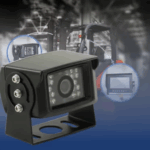
A GPS antenna is a vital component of any GPS (Global Positioning System) device, as it receives satellite signals and ensures accurate navigation. These antennas are designed to capture weak signals from satellites in space, converting them into usable data for location tracking, navigation, and timing. Selecting the right GPS antenna and understanding its types is critical for achieving reliable performance in various applications, including personal devices, automotive systems, and industrial uses.
What is a GPS Antenna?
A GPS antenna is a specialized receiver that picks up signals transmitted by GPS satellites orbiting Earth. These signals carry information about the satellite’s position and time, which the antenna relays to the GPS receiver. The receiver processes this data to calculate the device’s exact location. The efficiency of this process depends on the antenna’s design, quality, and placement.
Two common types of GPS antennas are active GPS antennas and passive GPS antennas. An active GPS antenna has an integrated low-noise amplifier (LNA) that boosts weak signals, while a passive GPS antenna lacks an amplifier and only collects and transfers the signal to the GPS receiver. Each type has its own applications, depending on the environment and device requirements.
Types of GPS Antennas
Understanding the different GPS antenna types is essential when selecting one for a specific use case. The choice of antenna impacts the performance and reliability of the GPS system.
1. Patch Antennas
Patch antennas are flat, rectangular, or square-shaped antennas commonly used in GPS devices. They are lightweight, compact, and suitable for integration into devices with limited space. Patch antennas are typically mounted on a ground plane to improve signal reception. These antennas are popular in automotive navigation systems, portable GPS trackers, and drones due to their small size and decent performance in open-sky conditions.
2. Helix Antennas
Helix antennas are designed with a spiral or helical shape, providing excellent signal reception even in challenging environments. They are ideal for applications requiring a wide field of view, such as aviation and marine navigation. Helix antennas are more robust than patch antennas and are suitable for environments with signal obstructions, such as urban areas or dense forests.
3. Chip Antennas
Chip antennas are miniature antennas used in small electronic devices, such as smartphones and wearable gadgets. These antennas are highly compact, making them suitable for internal placement within devices. While they save space, chip antennas may have limited performance compared to larger external antennas, especially in environments with signal interference.
4. GPS Internal Antennas
GPS internal antennas are built into devices to provide seamless and compact solutions. They are common in smartphones, tablets, and other portable gadgets where external antennas are impractical. While convenient, internal antennas may struggle with weak signals in areas with obstructions, such as indoors or urban environments.
5. External Antennas
External GPS antennas are mounted outside devices and are often larger than internal options. These antennas provide better signal reception and are commonly used in vehicles, industrial equipment, and other applications where performance is prioritized over compactness. They are typically used with active designs to amplify signals in weak reception areas.
Factors to Consider When Choosing a GPS Antenna
Selecting the right GPS antenna involves evaluating several factors to ensure optimal performance:
Frequency Band Compatibility
GPS signals are transmitted on specific frequency bands, such as L1 (1575.42 MHz) and L2 (1227.60 MHz). It is essential to choose an antenna compatible with the required frequency band for accurate signal reception. Many modern GPS antennas support multiple bands, enabling them to work with advanced systems like GLONASS and Galileo in addition to GPS.
Signal Amplification
For applications in areas with weak signals or significant obstructions, an active GPS antenna is preferable due to its built-in amplifier. The amplifier enhances the signal strength, ensuring reliable performance in challenging conditions. Passive antennas are more suitable for open-sky environments where signal strength is less of a concern.
Size and Placement
The size and placement of the antenna play a crucial role in its performance. External antennas generally provide better reception, but their size and mounting requirements may limit their use in compact devices. Internal antennas offer a space-saving alternative, although they may require careful positioning within the device to avoid interference from other components.
Environmental Conditions
The operating environment significantly impacts the choice of a GPS antenna. For outdoor applications exposed to harsh weather conditions, antennas with robust construction and waterproofing are essential. Conversely, for indoor or portable devices, compact and lightweight designs may be prioritized.
Applications of GPS Antennas
GPS antennas are widely used across industries and everyday applications. Their role in enabling accurate navigation and positioning makes them indispensable in modern technology.
Automotive Systems
In vehicles, GPS antennas power navigation systems, fleet tracking, and advanced driver-assistance systems (ADAS). External antennas are often mounted on car rooftops to ensure strong signal reception. These antennas enable real-time navigation and location tracking, improving efficiency and safety.
Aviation and Marine Navigation
Helix and external GPS antennas are commonly used in aviation and marine navigation systems. These environments demand reliable signal reception in remote and open areas, where obstacles are minimal but accuracy is critical. GPS antennas in these applications support navigation, communication, and emergency location systems.
Personal Devices
Smartphones, fitness trackers, and handheld GPS devices often use GPS internal antennas or chip antennas. These antennas provide compact solutions for location tracking and navigation in portable devices. Their small size allows seamless integration into the device’s design, although their performance may vary based on environmental factors.
Industrial and IoT Applications
Industrial equipment and Internet of Things (IoT) devices rely on GPS antennas for location tracking, asset management, and real-time monitoring. External antennas with active designs are preferred for their reliability in challenging environments, such as construction sites and remote monitoring stations.
Conclusion
A GPS antenna is a fundamental component of any GPS system, ensuring accurate navigation and reliable positioning across various applications. Understanding the different GPS antenna types, from patch and helix designs to GPS internal antennas, allows users to choose the right solution for their needs. Factors such as frequency compatibility, signal amplification, and environmental conditions influence the selection process. By selecting the right GPS antenna and optimizing its placement, users can achieve consistent performance, whether for automotive, industrial, or personal applications.







